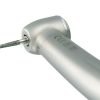Title: Occupational Hazards in Dentistry: A Comprehensive Review
Abstract
Dentistry, while vital for oral health, poses several occupational hazards to dental professionals. Among these hazards, neck-related issues stand out prominently due to the nature of dental work, which often involves prolonged periods of awkward neck positioning. This article comprehensively reviews the occupational hazards affecting the neck region among dentists, including musculoskeletal disorders, cervical spine degeneration, and associated risk factors. Moreover, preventive measures and ergonomic strategies are discussed to mitigate the risks and promote better occupational health and safety practices in dentistry.
Introduction
Dentistry is a demanding profession requiring precise manual dexterity and prolonged periods of focused work. However, the nature of dental procedures often necessitates awkward and static postures, predisposing dental professionals to various occupational hazards. Among these hazards, musculoskeletal disorders (MSDs) affecting the neck region are of particular concern due to their prevalence and potential long-term impact on the well-being of dental practitioners. This review aims to examine the occupational hazards associated with neck-related issues in dentistry, explore their underlying causes, and propose preventive measures to mitigate their effects.
Occupational Hazards Affecting the Neck
Musculoskeletal Disorders (MSDs)
Musculoskeletal disorders encompass a range of conditions affecting muscles, tendons, ligaments, nerves, and supporting structures of the body. In dentistry, MSDs commonly manifest as neck pain, stiffness, and discomfort due to prolonged static posture and repetitive movements during clinical procedures.
Source: Alexopoulos et al. (2019); Hayes et al. (2020)
Cervical Spine Degeneration
Prolonged periods of forward head posture and repetitive neck movements in dentistry contribute to cervical spine degeneration over time. Degenerative changes such as disc herniation, facet joint arthritis, and osteophyte formation may result in chronic neck pain and functional impairment.
Source: Gupta et al. (2018); Ohlendorf et al. (2021)
Risk Factors
Poor Ergonomics: Inadequate operatory design, improper patient positioning, and non-ergonomic equipment contribute to increased stress on the neck and cervical spine.
Repetitive Movements: Performing repetitive tasks without adequate rest intervals increases the risk of overuse injuries and MSDs.
Psychosocial Factors: High job demands, work-related stress, and job dissatisfaction may exacerbate neck-related symptoms among dental professionals.
Preventive Measures and Ergonomic Strategies:
Ergonomic Equipment: Investing in adjustable dental chairs, loupes, and ergonomic instruments promotes neutral neck positioning and reduces musculoskeletal strain.
Workplace Modifications: Optimizing operatory layout, arranging instruments within easy reach, and using saddle stools encourage proper posture and reduce the risk of neck injuries.
Regular Breaks and Stretching Exercises: Implementing regular rest breaks and incorporating stretching exercises into daily routines alleviate muscle tension and prevent the onset of neck pain.
Conclusion:
Neck-related occupational hazards pose significant challenges to the health and well-being of dentists. By understanding the risk factors associated with neck injuries and adopting ergonomic practices, dental professionals can minimize the prevalence of musculoskeletal disorders and promote a healthier work environment. Future research focusing on the efficacy of preventive interventions is warranted to enhance the occupational health and safety of dental practitioners.
References
Alexopoulos EC, Stathi IC, Charizani F. Prevalence of musculoskeletal disorders in dentists. BMC Musculoskelet Disord. 2004;5:16.
Gupta A, Bhat M, Mohammed M. A study on the prevalence of musculoskeletal disorders among dental practitioners in Bhopal, India. J Clin Diagn Res. 2018;12(6)
.
Hayes MJ, Cockrell D, Smith DR. A systematic review of musculoskeletal disorders among dental professionals. Int J Dent Hyg. 2020;18(2):173-185.
Ohlendorf D, Erbe C, Hauck I, et al. Spinal posture in dentistry – a comparison of three-dimensional back surface scanning and radiographic measurements. BMC Musculoskelet Disord. 2021;22(1):1-12.
 آراتیس | آراتیس تامین کننده مواد دندانپزشکی و تجهیزات دندانپزشکی
آراتیس | آراتیس تامین کننده مواد دندانپزشکی و تجهیزات دندانپزشکی

